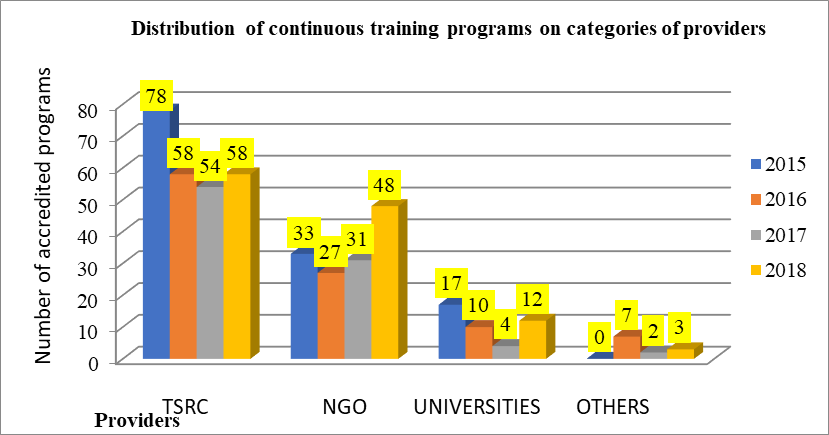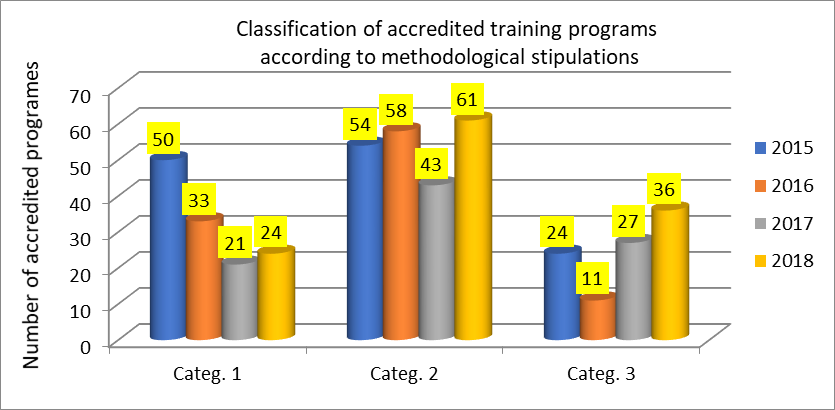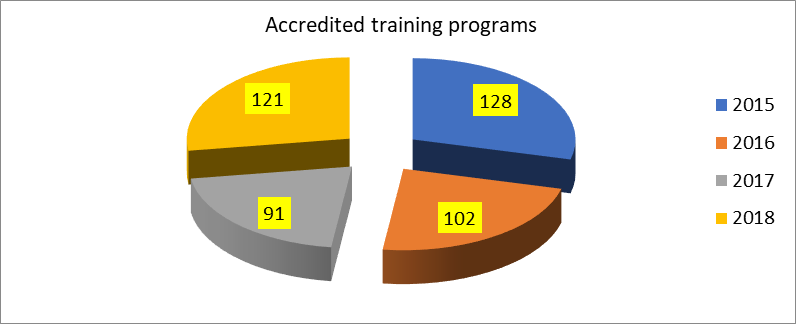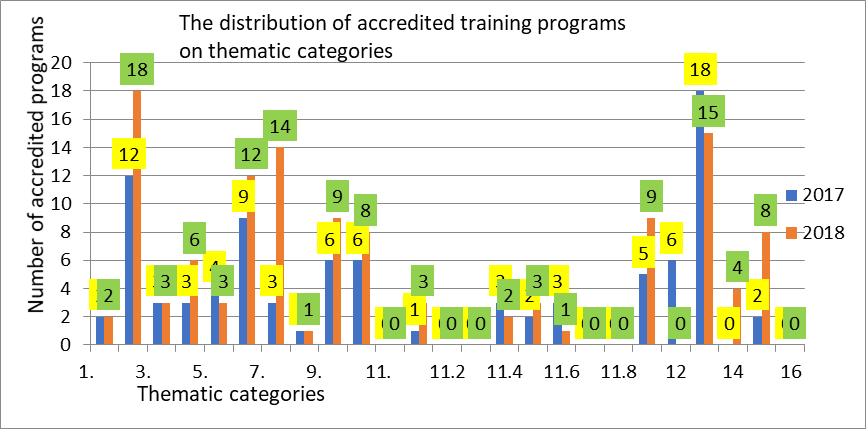Abstract
The Romanian system of continuous professional training is designed and organized according to a specific legal framework. The contemporary professional training of teachers in Romania is focused on developing the competence profile in line with the training standards for the teaching profession. It is considered to be a professional development route, but also an obligation - the teacher has to provide continuous training through the accumulation of a minimum number of professional credits. This can be done in two ways - continuing vocational training through teaching degrees, continuing vocational training through participation in specialized training programs. In this paper we follow the second way of continuous training - participation in training programs accredited by competent institutions. The programs are accredited according to a specific procedure and the teachers’ participation is conditioned by the legislative framework in force. The thematic areas where the training takes place are varied. They cover the competency profile of the education specialist, but also provide complementary skills. We will analyse the thematic directions on which the continuous training of the teaching staff is focused, the categories of training programs and their evolution during the recent period, their thematic evolution in relation to the training needs of the teachers from the pre-university level.
Keywords: Professional standards in the training of teaching staffcontinuous professional trainingthematic areas
Introduction
The educational reform from the Romanian pre-university cycle underwent numerous changes from a curricular point of view during the latest 10 years, through the modification of the main curricular documents and their reorientation in relation to educational finalities, even if these can be identified only in some schooling sectors:
The curricula for all schooling levels (primary, middle-school and high-school) have been restructured in point of disciplines, number of hours /discipline, new disciplines have been introduced and others have been removed, with a view to develop integrated curricula (the primary level curriculum includes integrated disciplines such as, Play and Movement, Music and Movement, Visual Arts and Technologies, continuing the curricular pattern of the preschool cycle);
The middle-school project level is in progress at the moment, the restructuring process being much more difficult due to some educational policy influences (legal measures adopted about educational printing houses, modifications in the number of hours for different disciplines, introduction of general electives such as Financial Education);
The educational reform is quasi-nonexistent at high-school level during recent years; although there are some sensible curricular modifications, there is no initiative as regards the modification, updating and revitalizing the curriculum of the learning disciplines as related to educational finalities.
These reorganizations at the educational policy and curricular reform level have extended gradually over the professional certificate exam and tenure examination, two fundamental exams which characterize the beginning of the teaching career in Romania. Whether the modality of progress of the professional certificate exam changed fundamentally in 2012 and then in 2017 (OM 4814 …, 2017), correlated to the updating of the examination programs, in terms of the tenure examination, one can mention an exacerbation of the organizational background – the introduction of a practical testing as an examination test with a weight in the final grade, a rise in the duration of the written exam to 4 hours, the cummulation of the specialty contents with the methodological and psycho-pedagogical ones in a unique written exams, as compared to the passivity at the national level in updating the examination programs (these are elaborated in 2010, preceding the modifications of the tenure exam organization and out of line with curricular modifications of the recent years).
These reorganizations of curricular policy exert pressures upon educational agents inevitably, accentuate the need of teachers’ continuous training, of professional reconversion, of initial training in new domains. A modality of professional development is ensured through teachers’ participation to continuous training programs which represents not only a professional engagement (OM 5564 … 2011; OM 5387 …, 2016), but also it ensures professional development through the development, broadening or completion with new competencies the competency profile corresponding to the didactic profession.
Problem Statement
The system of continuous training goes through several challenges: the compulsoriness of didactic career professionalization, the teacher’s qualitative initial training, continuous professional training and development /extension of professional competencies in order to meet the educational demands (Schleicher, 2012).
Most studies underline correlations among the quality of teaching, pupils’ performances and the quality of the educational system in general. Some of these are focused upon the direct association of pupils’ poor performances with the teaching forms exercised by the teacher (Darling-Hammond, 2000; Hattie 2003; Call, 2018), others target the interaction between teachers’ initial and continuous training and their effects at the level of educational system (Call, 2018).
The analysis of the efficacy of the teachers’ training system at an international level shows considerable differences, as some countries have national regulated standards for teachers’ training (Great Britain, Germany, Romania, USA), while others don’t (Norway, Canada) (OECD, 2013).
In the Romanian educational system, the national standards for continuous training in the didactic profession had been regulated in 2016 and are defined as necessary instruments to ensure the quality of accreditation and implementation processes in teachers’ continuous training and the professionalization of the didactic career programs in order to provide a coherent background of professional development. (OM 4476 approving the professional standards of continuous training for the didactic teaching function teacher in pre-university education, by educational level - preschool, primary, gymnasium and lyceum - and on stages of professional development in didactic career - didactic degree II, didactic degree I, continuous training every 5 years, 2016). These underline the importance of specialty and psycho-pedagogical (Păun, 2017; Cucoș, 2013), managerial, relational and communication competencies (Ezechil, Albu, & Pânișoară, 2008; Bloju, &Stan, 2013).
Research Questions
This study proposes to carry out a longitudinal analysis of the continuous training programs in terms of the predominant thematic directions, in relation to teacher’s competency profile. The question which arises from the perspective of an efficient continuous training is to what extent thematic evolution of the training is compatible with teachers’ training needs.
Purpose of the Study
An appropriate answer to the above-mentioned issues can be given if one takes into account the following targets: which are the most active categories of continuous training providers on teachers’ training market, which are the categories of professional competencies teachers want to develop /extend and what are the thematic domains which appeal to teachers’ continuous training?
Research Methods
In order to fulfil the objectives of the study, we have analysed the normative documents which include the list of continuous programs and providers accredited during 2015 – 2018. (The national register of accredited continuing training programs, 2018)
Findings
The analysis of the progress of continuous training programs during 2015 - 2018
In the Romanian system these programs are designed, accredited and provided by accredited institutions, stipulated in the national legal framework (OM 5564 …, 2011; OM 5387 …, 2016): a) MEN related units (
Among all providers, the most intensive activity as regards the accreditation of continuous training programs has been developed by provider a) –

The progress of continuous training programs is achieved through three categories of programs (OM 5564 approving the methodology of accreditation and periodic evaluation of the providers of continuous training and the training programs offered by them, 2011; OM 5387 approving the methodology of accreditation and periodic evaluation of the providers of continuous training and the training programs offered by them, 2016):
category 1 – professional development programs according to the art. 244 from the Education Law/2011 (updating /development of competencies in the specialization domain corresponding to the didactic position, in the psycho-pedagogical and methodological domain; development of competencies for the evolution of the didactic career; acquisition and/or development of managerial, guidance and control competencies);
category 2 – professional development programs in accordance with the policies and strategies of the Ministry of Education (acquisition of complementary competencies; development and extension of transversal competencies);
category 3 – modular programs achieved through non-disciplinary stages;
category 4 – special programs.

The analysis of the accreditation volume for the category 1 training programs shows the biggest amount of activity in 2015 (50%), while for the categories 2 and 3 in 2018 (61%, respectively 36%). The category 2 programs register the biggest frequency in accreditation during this period, showing the providers’ interest for the acquisition of professional competencies (computer-assisted teaching, teaching in foreign languages, educational counselling and orientation in career, adult education), the development and extension of transversal competencies as concerns interaction and communication with the social and pedagogical environment. (Figure

The evolution of continuous training programs as regards thematic domains proves to be fairly interesting. In 2017 most accredited training programs developed in the domain D.13.

Discussions
In the matter of categories of providers the evolution of the accredited continuous training programs during the last 4 years underlines a rise in this activity at the level of
In the last two years, the teaching staff training needs identified by the training providers manifested in order to acquire complementary professional competencies (computer-assisted teaching, teaching in foreign languages, educational counselling and orientation in career, adult education), the development and extension of transversal competencies as concerns interaction and communication with the social and pedagogical environment. This fact can be a cogent indicator as regards the necessity of revizing and updating the teacher’s professional competency profile as related to the demands of the current educational market (teaching in a widely spoken language, the use of digital technology in the educational activity, educational counselling). The interest for continuous training in the domains of educational management and didactic technology represents another indicator as concerns the necessity of developing methodological and managerial competencies of the teaching staff. These elements should not astonish us taking into consideration the width of curricular modifications of the latest years which emphasize integrated design, the use of active /interactive strategies, the use of digital instruments, pupil-centered education, the development of pupils’ transversal competencies.
On the other hand, the current evaluation system of pre-university teaching staff in Romania takes into account the participation of teachers to accredited continuous training programs, the points rating being higher for the programs in the educational mangement domain.
Conclusion
The progress of the educational act under optimal conditions can only be achieved if one takes into consideration the updating of the teacher’s competency profile and its redefining from the point of view of the curricular reform and of educational policies at the level of the categories of competencies. The improvement of methodical and psycho-pedagogical competencies will be achieved in terms of experiencing and applying new educational technologies, new pupil-centered interactive strategies, the integration of didactic contents, the inter /transdisciplinary design of educational activities, competency evaluation. The development of managerial competencies must be achieved taking into account styles and strategies of the educational act and class efficient management in different school contexts and outside them. The powerful development of the special needs phenomenon in the Romanian school requires the extension of the teacher’s counselling competencies in order to ensure the cognizance and use of psycho-pedagogical methods to identify pupils’ age and individual characteristics but also in order to organize and develop counselling activities for parents and school partners. Moreover, the development of transversal competencies – digital, cultural awareness, socio-emotional, intercultural etc. will complete the professional profile of an efficient teacher..
References
- Bloju, C.L., & Stan, R.V. (2013). Didactic Communication - Key Element for Any Successful Teaching Activity. Procedia Social and Behavioral Sciences, 76, 105–109.
- Call, K. (2018). Professional Teaching Standards: A Comparative Analysis of Their History, Implementation and Efficacy. Australian Journal of Teacher Education, 43(3). DOI:
- Cucoș, C. (2013). Educaţia. Experienţe, reflecţii, soluţii [ Education. Experiences, reflections, solutions]. Iaşi: Polirom.
- Darling-Hammond, L. (2000). Teacher Quality and Student Achievement: A review of state policy evidence. Education Policy Analysis Archives, 8(1), 1-44. Retrieved from https://epaa.asu.edu/ojs/article/view/392/515
- Ezechil, L., Albu, G., & Pânișoară, I.-O. (2008). Comunicarea si relațiile de comunicare pedagogică. Structură, mecansime, forme, stiluri, eficacitate. In: D. Potolea, D., I. Neacsu, I.-O. Pânișoară (2008). Pregătirea pshihopedagogica. Manual pentru definitivat și gradul didactic II [Psyophopedagogic training. Manual for Completion and Didactic Degree II]. Iași: Polirom.
- Hattie, J.A.C. (2003). Teachers make a difference: What is the research evidence? In: The Building Teacher Quality: What does the research tell us ACER Research Conference (ACER). Retrieved from https://research.acer.edu.au/cgi/viewcontent.cgi?article=1003&context=research_conference_2003
- OECD (2013). Learning Standards, Teaching Standards and Standards for School Principals. Retrieved from http://www.oecd.org/officialdocuments/publicdisplaydocumentpdf/?cote=EDU/WKP(2013)14&docLanguage=En
- OM 5564 approving the methodology of accreditation and periodic evaluation of the providers of continuous training and the training programs offered by them (07.10.2011). Retrieved from https://www.edu.ro/formare-continua
- OM 4476 approving the professional standards of continuous training for the didactic teaching function teacher in pre-university education, by educational level - preschool, primary, gymnasium and lyceum - and on stages of professional development in didactic career - didactic degree II, didactic degree I, continuous training every 5 years (06.07.2016). Retrieved from https://www.edu.ro/formare-continua
- OM 5387 approving the methodology of accreditation and periodic evaluation of the providers of continuous training and the training programs offered by them (30.09.2016). Retrieved from https://www.edu.ro/formare-continua
- OM 4814 approving the framework methodology for organizing and carrying out the national exams in education (31.08.2017). Retrieved from http://definitivat.edu.ro/2018/docs/OM%20Metodologie%20MO.pdf
- Păun, E. (2017). Pedagogie. Provocări şi dileme privind şcoala şi profesia didactică [Pedagogy. Challenges and Dilemmas on School and Teaching]. Iaşi: Polirom.
- Schleicher, A. (2012). Ed. Preparing Teachers and Developing School Leaders for the 21st Century: Lessons from around the World. Retrieved from https://www.oecd.org/site/eduistp2012/49850576.pdf
- The national register of accredited continuing training programs (2018). Retrieved from https://www.edu.ro/sites/default/files/Registrul%20national%20al%20programelor%20de%20formare%20continua%20acreditate%20_%20martie%202018.pdf
Copyright information

This work is licensed under a Creative Commons Attribution-NonCommercial-NoDerivatives 4.0 International License.
About this article
Publication Date
15 August 2019
Article Doi
eBook ISBN
978-1-80296-066-2
Publisher
Future Academy
Volume
67
Print ISBN (optional)
-
Edition Number
1st Edition
Pages
1-2235
Subjects
Educational strategies,teacher education, educational policy, organization of education, management of education, teacher training
Cite this article as:
Tudor*, S. L., Mircea, N. E., & Negreanu, M. (2019). Directions In Teachers’ Continuous Training In Pre-University Education. In E. Soare, & C. Langa (Eds.), Education Facing Contemporary World Issues, vol 67. European Proceedings of Social and Behavioural Sciences (pp. 2220-2227). Future Academy. https://doi.org/10.15405/epsbs.2019.08.03.275
